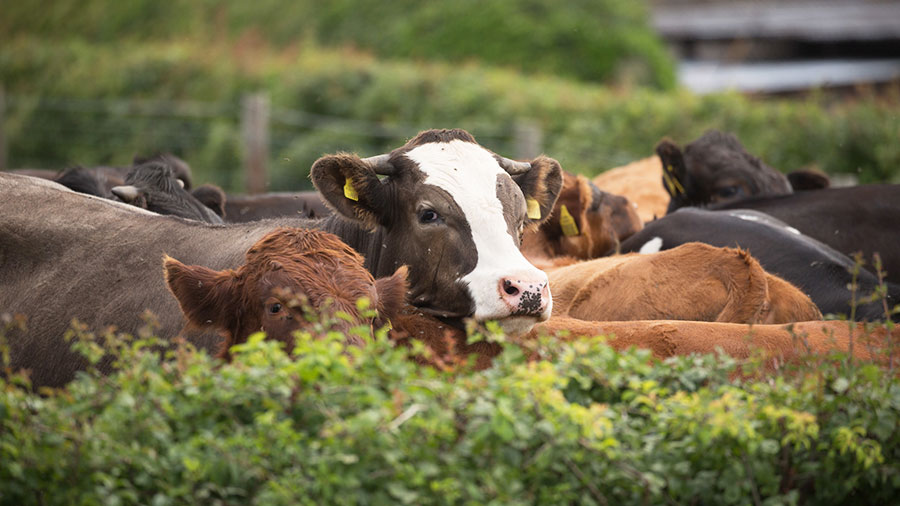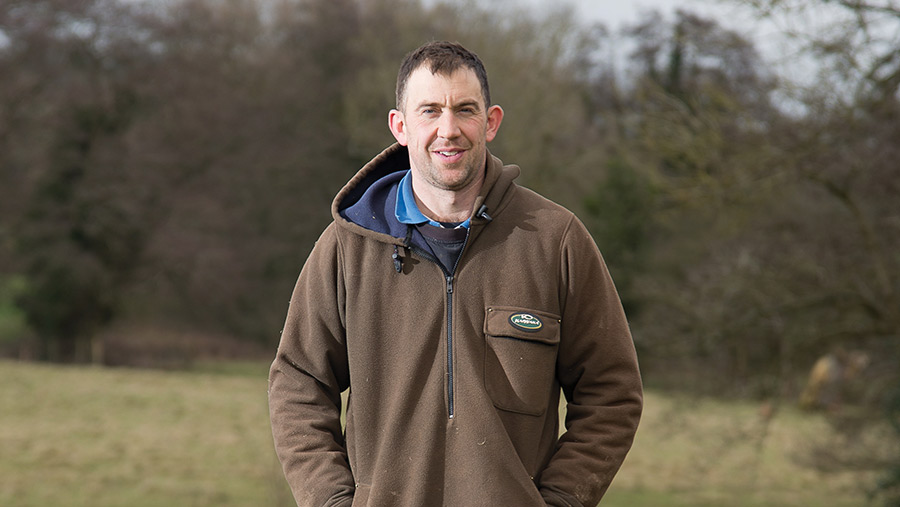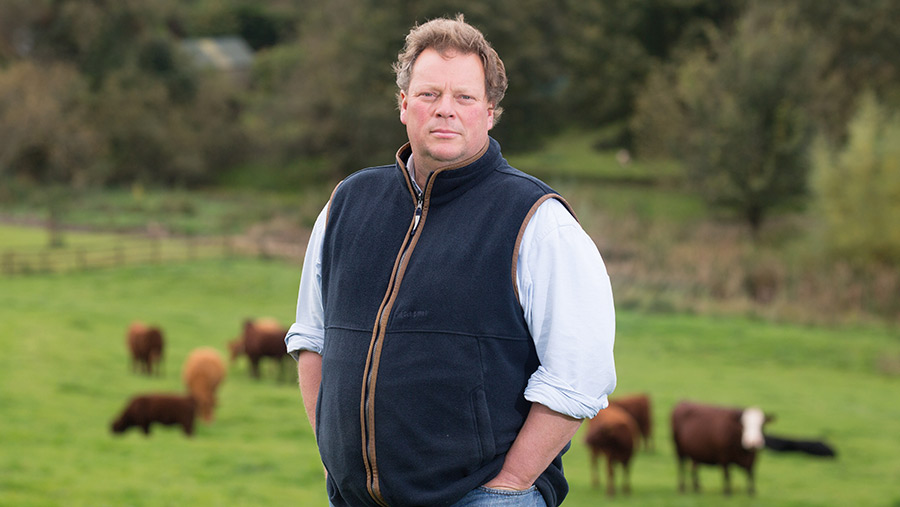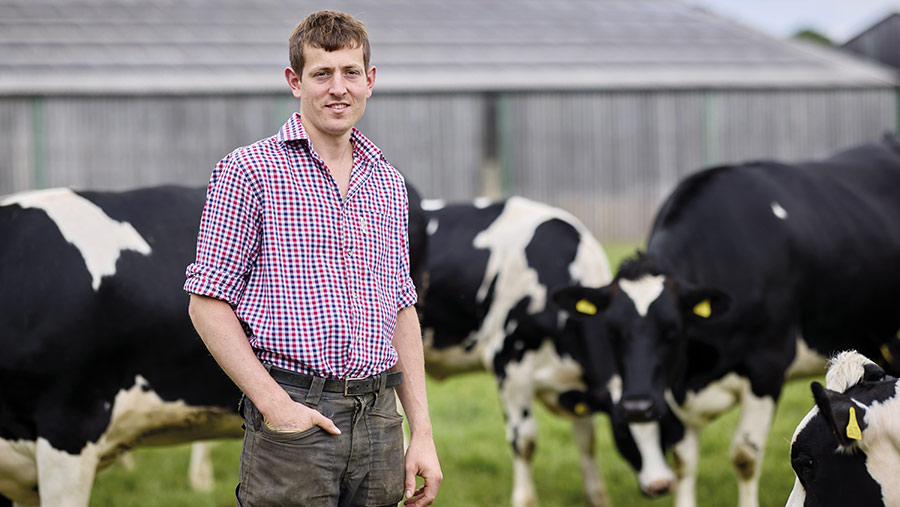3 livestock farmers’ environmental management plans for 2022
 © Tim Scrivener
© Tim Scrivener With the Sustainable Farming Incentive opening in 2022, farmers under increasing pressure to raise their environmental credentials.
We speak to three livestock producers who explain how environmental management has already benefited their businesses and what they pledge to do in the future.
See also: How an upland farm is adapting to survive without subsidies
Sheep
Rich Thomas, Risbury Court, Herefordshire

Rich Thomas © Russell Lewis Photography
Farm facts
Risbury Court
- 120ha (300 acres) in Higher Level and Mid Level Stewardship
- 300 Romney cross Aberfield ewes put to a Romney or Focus Prime tup
- Lambs sold deadweight, mostly to Tesco, as well as local butchers and restaurants
- 50 pedigree Hereford cows
- 12ha (30-acre) apple orchard and 10ha (25 acres) of arable
What steps have you taken to get on the front foot in terms of environmental management?
We’re farming in a more holistic way. We graze on a target 30- to 90-day rotation, depending on the time of year and how much each field needs; in winter, we try to achieve 150 days. That leads to more roots and more soil organic matter, which helps the carbon cycle.
If we can increase our soil carbon and, perhaps more importantly, the active carbon, we will improve our soil and grass growth.
We have planted hedgerows and reduced hedgetrimming to encourage wildlife, and continue to use deep-rooting species such as chicory and plantain on temporary grassland.
Last year, as it was so dry, we didn’t have the right conditions to use bagged nitrogen in the spring. I left it in the shed and we grew more grass from better grazing management.
I realised we could manage without it. Increasing grassland legume content has helped, too.
How have these steps benefited your business?
By providing more space for nature, we have seen the farm ecosystem come into balance. More insects mean more birds, more bats and more predatory insects such as dragonflies.
It has also reduced our costs. I don’t believe low input has to be low output. Initially, we may lose output, but in the medium term, it will go up and our stocking rate will increase.
What do you pledge to do in 2022?
More of the same, and we hope to plant more than 500 trees as part of a Woodland Trust agroforestry project. We’ll plant willows, hazel and fruit and nut trees.
Letting cattle and sheep browse the trees may help us stop bolusing and drenching. Willow is high in cobalt and tannins; the latter can help animals self-medicate for worms.
Cobalt must be mined, a process known to be environmentally and often socially damaging.
Beef
David Barton, Manor Farm, Cirencester, Gloucestershire

David Barton © AHDB
Farm facts
Manor Farm
- 100ha (255 acres) – 45ha (111 acres) GS4 mixes and 12ha (30 acres) cereals. The rest is permanent pasture and woodland
- 70 spring-calving Salers-cross cows, served to Salers and Sussex bulls
- Calves sold to Dovecote Park
- Was 50:50 arable and beef, now moving to beef as it is more sustainable on marginal arable land
What steps have you taken to get on the front foot in terms of environmental management?
When our Higher Level Stewardship ended, we went on to Countryside Stewardship. We have planted 45ha (111 acres) of GS4 legume-rich leys, which help build soil organic matter.
This will help our carbon footprint, because for each 0.1% increase in organic matter, we’re sequestering 9t of carbon/ha (3.6t/acre).
The leys also provide feed for cattle, while giving us financial stability over five years as we’re paid £309/ha (£125/acre). We’re rotationally grazing and improving silage quality. That should lower our carbon footprint.
My aim is to be carbon net-zero on the beef. In March, our carbon footprint was 26.77kg carbon dioxide equivalent (CO2e)/kg for beef (excluding soil carbon) versus a national average from Agrecalc of 38.05kg CO2e/kg.
How have these steps benefited your business?
We have reduced our age at finish from an average of 27 months to 20 months, and we should achieve 18 months this year. Financially, that’s good for me, but also good for the environment.
This year we’ve generally finished cattle off grass and reduced barley use. It will cut the number we have to house over a second winter, which will lower costs.
What do you pledge to do in 2022?
We’re going to cut our nitrogen fertiliser use, as that’s a huge emitter of nitrous oxide. Planting legumes will help with that.
We will also look to direct-drill grasses and see whether we can do that with cereals, too.
Dairy
Tom Pattison, Willow Tree Farm, Thrintoft, North Yorkshire

Tom Pattison © Arla Foods/Chris Rout
Farm facts
Willow Tree Farm
- Family farm
- About 162ha (400 acres) farmed
- 290-cow herd
- 12,000 litres a cow a year at 4.2% fat and 3.42% protein
- Arlagarden milk contract
- Grow grass, maize and winter wheat
- Cows housed and calve year-round
What steps have you taken to get on the front foot in terms of environmental management?
A climate check carried out last year by our milk buyer, Arla, showed we had a carbon footprint of 0.87kg CO2e/kg of fat- and protein-corrected milk.
One of the main recommendations to reduce that was to lower age at first calving.
We have changed our pneumonia vaccination policy, which has reduced pneumonia by more than 50% and helped improve growth rates.
This means we’re now serving heifers from 12 months old and calving from 23 months. It has also lowered antibiotics use.
I have started genomic-testing heifers and breeding the top heifers and cows to sexed semen and the rest to Aberdeen Angus.
We use a mating programme and breed for profitable lifetime index, mastitis resistance, yields, fats and proteins.
We also have solar panels and a heat exchanger that uses the heat from the milk cooler to warm plant-wash water.
How have these steps benefited your business?
By maximising health and selecting for mastitis resistance, we will keep the herd healthier and reduce antibiotics use.
The healthier cows are, the longer they’ll live, which will benefit the business and our carbon footprint.
The earlier we calve heifers, the quicker they produce milk and the cost to get them to that point decreases. That will improve our carbon footprint, as we have fewer heifers that are not productive.
The solar panels have halved our electricity costs in the summer.
What do you pledge to do in 2022?
We are working towards a 3% annual reduction to help Arla achieve an overall 30% reduction in carbon emissions by 2030.
Next year, we will be completely soya-free. Soya is known to have a high carbon footprint, and it’s likely we won’t be able to use it in future, so we’re already planning for that.
We’ve started feeding heat-treated rapemeal and we’ve taken out soya hulls and moved on to pressed sugar beet pulp.
We’re looking to use less fertiliser and make better use of slurry and muck by targeting them to the fields that need it, using soil analysis.
